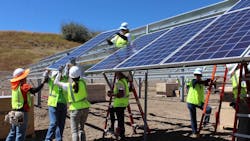Can the Future of Commercial Solar Be Community Solar?
The role of solar energy in the commercial and industrial (C&I) sector serves multiple purposes. It can reduce overhead electricity expenses in ways that improve the bottom line, while also lowering a business’ carbon footprint to satisfy federal, state, and consumer interest in corporate sustainability.
While big box retailers, namely the Targets and Walmarts of the world, have made a splash in recording-breaking rooftop solar installations, many C&I businesses in less opportune positions are finding an alternate route of entering the solar market with community solar.
What is Community Solar?
Community solar is an off-site solar array typically built on open land in which local community residents and businesses can either lease or buy a portion of the solar panels in the array. Community solar customers, known as ‘subscribers,’ then receive credit on their electricity bills for their share of the power produced. Busineses can earn status as a green energy user.
Traditional solar rooftops can be a large expense for businesses, despite declining system costs. The projects are heavily dependent on building ownership, surrounding shade coverage, and a myriad of other mitigating circumstances. Community solar projects remove these restrictions and open the door for businesses that rent, have limited funding or lack conducive rooftop/carport space to access the financial and environmental savings of solar.
Incentivizing Shared Solar
With 3.4 GW of community solar installed in the U.S. to date and an anticipated 4.3 GW to be added by 2026, according to the Solar Energy Industries Association, a burst of new community solar corporate subscriptions may just be in sight.
An impressive 22 states and Washington, D.C. have already implemented policies in support of community solar projects - good news considering mass adoption of renewables often hurdles at the policy level. Development of community solar in Minnesota and Massachusetts, for example, boomed thanks to the state programs. Just this year, Oregon saw the completion of its first three solar farms as part of its state-led program. Of the subscribers were Daimler Trucks, WorldMark by Wyndham, and a range of small-to-medium businesses.
As states continue to incentivize community solar, and more awaken to the idea, businesses will have much greater opportunities to find projects in their area to participate.
Why Many Businesses Opt for Community Solar
From an investment perspective, businesses looking to avoid the high upfront price tag of an onsite solar system can instead invest in a certain kilowatt capacity or kilowatt per hour of production, making it a much more affordable option. For many, spending even a modest amount of money to market ‘Powered by Clean Energy’ can become a return on investment in brand lift.
Many businesses also benefit from the flexibility of community solar. An agreement with the community solar developer and the array itself can stay intact even if the business changes locations - given the move remains within the same utility service territory. Same applies should a business’ energy needs change, particularly as it scales. Community solar subscribers can adjust the number of panels in their share according to usage changes.
C&I corporations opting into community solar can range from hotel chains and car dealerships to law offices, gas stations, and everywhere in between. Places like grocery stores and laundromats, that have high energy demands from running refrigerators and washing machines, stand to save a tremendous deal on electricity bills.
Go Green to Save Green
The sustainability movement in America has picked up tremendous momentum over the last few years and is accelerating. Businesses recognize consumers now expect the companies they do business with to prioritize environmentally conscious practices, and the U.S. Administration seems set to execute on ambitious solar goals. Yet, solar - even the most accessible renewable energy resource available to the masses - is still out of reach for many.
Community solar can solve this, even if just a portion. For a fraction of the cost of traditional solar, businesses can cut their carbon footprint, save on electricity costs, and support the use of renewable energy all in one smart business decision.
